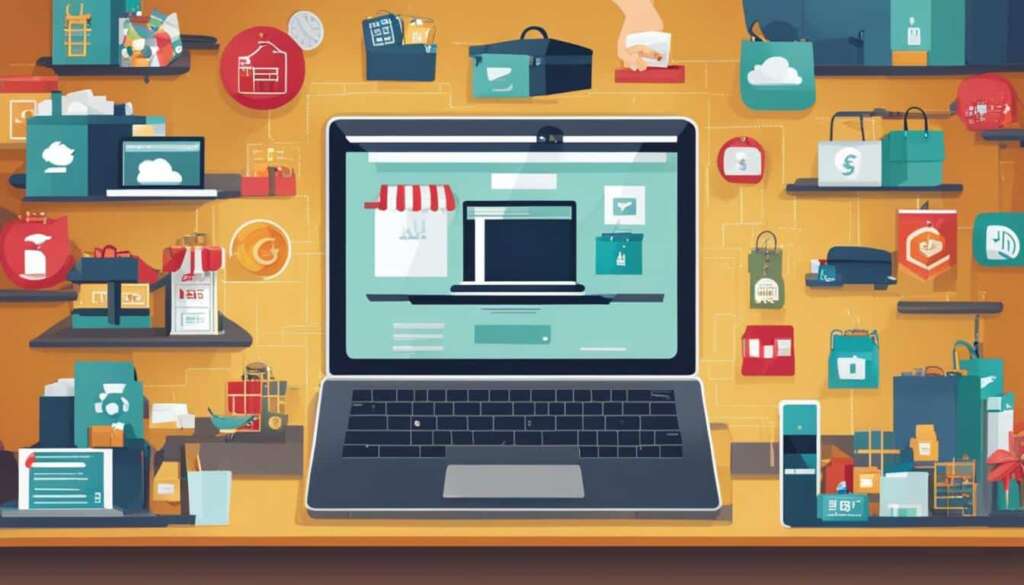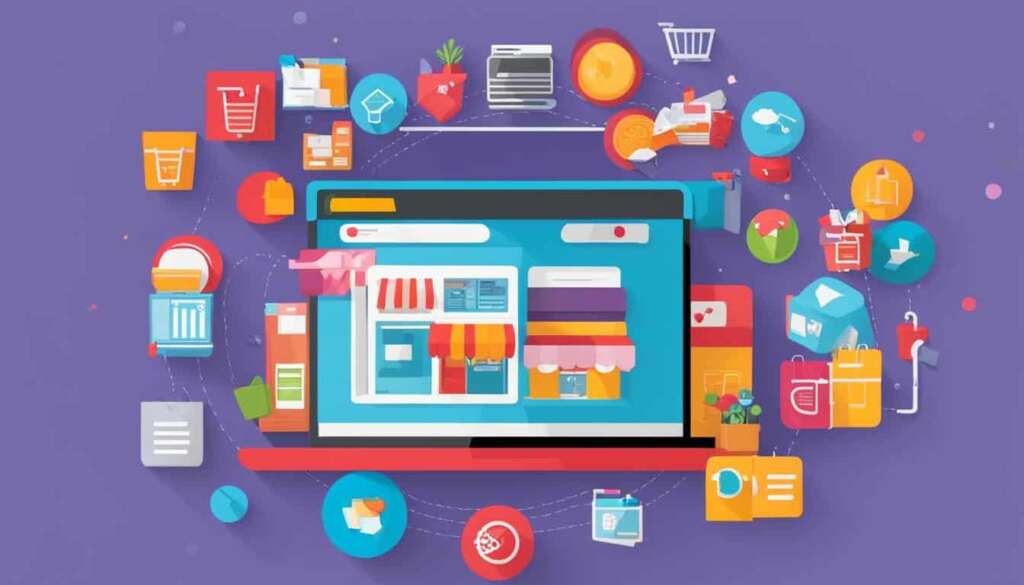Table of Contents
E-commerce has revolutionized the way small businesses operate and has become a key driver of economic growth. In today’s digital age, small businesses must adapt and implement effective strategies to thrive in the competitive e-commerce landscape. This article will explore essential strategies that small businesses can employ to achieve growth and success in 2023.
With the global e-commerce market projected to reach 58.74 trillion by 2028, it is crucial for small businesses to seize the opportunities presented by the online market. To position themselves for growth, small businesses need to optimize their websites, create valuable content, strengthen their social media presence, update their email marketing lists, offer new products, utilize augmented reality experiences, ensure mobile-friendliness, build a niche brand, enhance their fulfillment processes, tap into the international market, and create a seamless checkout experience.
By implementing these strategies, small businesses can maximize their online potential and capitalize on the growing e-commerce industry. In the following sections, we will delve deeper into each strategy, unpacking the steps required for successful implementation. Through diligent execution and a customer-centric approach, small businesses can achieve sustainable growth and establish themselves as formidable players in the e-commerce landscape.
Optimize Your Website
To ensure business growth in 2023, it is crucial for small businesses to optimize their websites. A well-designed and customer-friendly site can enhance the user experience, drive conversions, and improve overall performance.
Working with professionals who specialize in web design is highly recommended. They can provide valuable insights and expertise to create an intuitive website that aligns with your e-commerce goals. A visually appealing layout, easy navigation, and clear product descriptions are essential elements of a conversion-friendly site.
Implementing proper SEO techniques is another crucial aspect of website optimization. By optimizing your website for relevant keywords and improving your search engine rankings, you can attract more organic traffic and increase your online visibility. This can be achieved through strategic keyword placement, meta tag optimization, and optimizing your site’s URL structure.
Integrating chatbot features can also enhance customer interaction and provide immediate assistance. Chatbots can answer frequently asked questions, guide customers through the purchasing process, and offer personalized recommendations. This can significantly improve user engagement and increase the chances of conversion.
Furthermore, providing appointment or meeting scheduling options on your website can streamline the customer journey and boost conversions. By offering the convenience of scheduling appointments or meetings directly from your site, you can provide a seamless experience for potential customers.
Benefits of Website Optimization:
Optimizing your website has numerous benefits for your e-commerce business, including:
- Improved user experience and customer satisfaction
- Increased search engine visibility and organic traffic
- Enhanced brand image and credibility
- Higher conversion rates and sales
- Better customer engagement and retention
By investing in website optimization, small businesses can create a competitive edge in the e-commerce market and achieve sustainable growth.
Create Content… And Then Create Some More!
Creating valuable content is essential for e-commerce success. In order to cater to customer preferences and engage your target audience effectively, small businesses should adopt a proactive approach towards content creation. Here are some strategies to help you create content that resonates with your customers:
1. Understand Customer Preferences through Surveys
Conducting surveys is an effective way to gain insights into your customers’ preferences. By understanding what they are looking for in terms of content, you can tailor your strategy to meet their needs. Use tools and platforms to create and distribute surveys, asking questions that will provide valuable feedback. Analyze the data and use it to inform your content creation process.
2. Analyze Competitors’ Content Strategies for Inspiration
Take a closer look at what your competitors are doing in terms of content creation. Identify successful strategies that align with your brand and industry, and draw inspiration from them. This doesn’t mean copying their content, but rather learning from their approach and adapting it to suit your own unique voice and style.
3. Brainstorm Based on Product Knowledge
Your own product knowledge is a valuable resource for content creation. Brainstorm ideas that showcase the unique features and benefits of your products. Think about how your audience would benefit from this information and tailor your content accordingly. Highlight the value proposition and address any pain points your customers may have.
4. Explore Various Content Formats
Avoid sticking to just one type of content. Diversify your content formats to cater to different audience preferences. Consider creating videos, blogs, podcasts, and paid advertising campaigns. Experiment with different formats and analyze which ones resonate most with your target audience.
| Content Format | Benefits |
|---|---|
| Videos | – Engaging and visually appealing – Easily consumable – Can showcase products and demonstrations effectively |
| Blogs | – Allows for in-depth explanations – Helps improve search engine rankings – Provides a platform for thought leadership |
| Podcasts | – Offers a convenient and portable format – Can build a loyal following – Allows for conversations and interviews with industry experts |
| Paid Advertising | – Increases reach and visibility – Allows for precise targeting – Can drive immediate conversions |
Remember, the key is to create compelling and informative content that aligns with your brand and provides value to your customers. Focus on quality, relevance, and consistency to build a loyal following and keep your audience engaged.
By leveraging customer preferences, analyzing competitors’ strategies, brainstorming based on product knowledge, and diversifying content formats, small businesses can create content that effectively engages their target audience and drives e-commerce success.
Strengthen Your Social Media Strategy
A strong social media strategy is crucial for driving customers to e-commerce stores. In today’s digital age, social media platforms provide small businesses with a powerful tool to engage with their target audience, build brand awareness, and drive sales. Small businesses can capitalize on the popularity of social media by leveraging various strategies to maximize their online presence and connect with potential customers.
Leverage Live Streaming
Live streaming is gaining popularity in the e-commerce industry as it allows businesses to connect with their audience in real-time. By hosting live streaming sessions, small businesses can demonstrate product features, offer exclusive discounts, and interact with viewers through live chat features. This interactive experience helps to build trust and engagement, leading to increased conversions and sales.
Utilize Social Media Chatbots
Social media chatbots are a valuable tool for small businesses to provide instant customer support and enhance the user experience. By utilizing chatbots, businesses can automate responses to frequently asked questions, provide product recommendations, and assist customers with their purchase decisions. This not only saves time but also improves customer satisfaction and increases the likelihood of making a sale.
Create Engaging Stories
Stories have become a popular feature on social media platforms, such as Instagram and Facebook. Small businesses can take advantage of this trend by creating engaging and compelling stories that showcase their products, behind-the-scenes content, and customer testimonials. Stories provide a sense of authenticity and immediacy, allowing businesses to connect with their audience on a personal level and drive engagement.
Utilize Paid Advertisements
Paid advertisements on social media platforms offer small businesses a targeted and cost-effective way to reach their desired audience. By carefully crafting and targeting ads, businesses can drive traffic to their e-commerce store, increase brand visibility, and generate leads. In addition, social media platforms provide advanced targeting options, allowing businesses to reach specific demographics, interests, and geographical locations.
In-App Purchases
Integration of in-app purchases enables small businesses to streamline the buying process and improve the user experience. By offering in-app purchases, businesses can reduce friction in the purchasing journey, allowing customers to make quick and seamless transactions without leaving the social media platform. This feature enhances convenience and encourages impulse buying, contributing to increased sales and customer satisfaction.
Building a comprehensive social media strategy is essential for small businesses looking to increase their online presence and drive sales. By leveraging live streaming, social media chatbots, and stories, businesses can engage with their audience in meaningful ways. Paid advertisements and in-app purchases further enhance the effectiveness of a social media strategy by driving traffic and converting potential customers into buyers.
Filter and Update Your Email Marketing List
Email marketing, although it may be considered an older form of digital marketing, remains a highly effective strategy for e-commerce businesses. By utilizing email campaigns, small businesses can directly reach their target audience and drive sales. However, it is crucial to regularly filter and update your email marketing list to ensure optimal results.
Importance of Filtered Lists for Targeted Campaigns
An email marketing list that is outdated or filled with irrelevant contacts can greatly hinder your marketing efforts. By filtering and updating your list, you can create targeted campaigns that are personalized to the preferences and interests of your audience. This increases the likelihood of engagement and conversions, resulting in a higher return on investment (ROI).
One effective way to filter your email marketing list is by sending out a questionnaire to your subscribers. This allows you to gather valuable information about their preferences, interests, and purchasing behavior. Based on these insights, you can segment your list and tailor your marketing campaigns to specific customer segments.
Personalization and Engagement
Personalization is key in email marketing. By addressing each subscriber by their name and delivering relevant content, you can create a more engaging and impactful email experience. Personalized emails have been proven to generate higher open rates, click-through rates, and conversions.
When updating your email marketing list, make sure to remove inactive subscribers or those who have unsubscribed. By keeping your list clean and up-to-date, you can focus your resources on those who are genuinely interested in your products or services.
“Filtering and updating your email marketing list is crucial for creating targeted and personalized campaigns that drive engagement and conversions.”
The Role of Automation
Automation tools can greatly simplify the process of filtering and updating your email marketing list. These tools allow you to set up triggers and workflows that automatically segment subscribers based on their actions and preferences. With automation, you can send targeted emails at the right time, nurturing leads and guiding them through the customer journey.
| Benefits of Updating Your Email Marketing List: |
|---|
| • Increased email deliverability |
| • Higher open and click-through rates |
| • Improved engagement and conversions |
| • Reduced spam complaints |
Updating your email marketing list is not a one-time task but an ongoing process. Regularly assess the performance of your campaigns, analyze subscriber behavior, and make necessary adjustments. By continuously refining your list, you can ensure that your email marketing remains effective and contributes to the growth of your e-commerce business.
Offer Items You Didn’t Offer in the Past
The COVID-19 pandemic has drastically changed customer buying behavior, leading to a significant surge in online purchases. To capitalize on this trend and drive growth in your e-commerce business, it’s vital to offer new products that may not have been part of your previous offerings. By diversifying your product range, you can attract new customers and stimulate sales.
This shift in customer buying behavior offers small businesses a unique opportunity to cater to evolving needs and preferences. By introducing new products, you can tap into untapped markets, entice customers who are seeking fresh options, and stay ahead of the competition. Whether it’s innovative gadgets, trending fashion items, or niche-specific merchandise, expanding your product line can create excitement among customers and boost your e-commerce success.
Customer Buying Behavior and E-commerce Success
Understanding customer buying behavior is crucial for e-commerce success. The pandemic has resulted in consumers reevaluating their shopping habits and developing a preference for online shopping. By offering items that align with their changing needs and preferences, you position your business as a trusted and adaptive brand.
Customer buying behavior is not static but constantly evolving. By staying attuned to the shifting preferences of your target audience, you can adapt your product offerings to meet their demands and enhance your e-commerce success.
Diversifying your product offerings has several benefits. Firstly, it allows you to attract new customers who may not have been interested in your previous product range. Bringing in fresh products can pique their interest and draw them to your e-commerce store. Additionally, offering new items helps retain existing customers, preventing them from seeking alternatives elsewhere.
| New Products Advantages | Benefits |
|---|---|
| Attract New Customers | Expand your customer base and reach a wider audience. |
| Retain Existing Customers | Keep your current customers engaged and discourage them from exploring competitive options. |
| Generate Buzz and Excitement | Drive anticipation and create a buzz around your brand, resulting in increased brand awareness and customer engagement. |
| Boost Sales | Increase revenue by capitalizing on new market segments and customer demands. |
Remember to conduct thorough market research and stay informed about the latest trends and customer preferences. This will help you identify which new products are likely to resonate with your target audience, ensuring that your expansion efforts yield the desired results.
By offering new products that meet the evolving needs of customers and staying adaptable to changing buying behavior, your small e-commerce business can thrive and secure long-term growth in a highly competitive market.
Augmented Reality Experiences
Augmented reality (AR) is revolutionizing the e-commerce industry, providing customers with immersive and interactive shopping experiences. By incorporating 3D modeling technology, small businesses can offer customers a realistic preview of how products will look in their own homes or real-life settings.
Investing in 3D modeling enables small businesses to showcase their products in a visually engaging and dynamic way. Customers can explore products from different angles, zoom in for closer inspection, and even visualize how items will fit into their existing spaces. This enhanced level of detail and interactivity boosts customer confidence and reduces the likelihood of returns, improving the overall shopping experience.
In addition to 3D modeling, small businesses should also consider utilizing live-streaming shopping events to further engage with customers. These events provide an opportunity to showcase products in action, answer customer questions in real time, and provide in-depth product demonstrations. By leveraging live-streaming, small businesses can create a sense of exclusivity and urgency, driving customer interest and increasing sales.
AR experiences and live-streaming shopping events are transforming the way customers interact with e-commerce businesses. By embracing these technologies, small businesses can stand out from their competitors, build brand loyalty, and enhance the overall customer journey.
Augmented reality experiences are increasingly adopted by well-known e-commerce brands such as IKEA, ASOS, and Wayfair. These businesses have successfully implemented AR solutions to enable customers to visualize furniture in their homes, try on virtual clothing, and even virtually decorate their living spaces. By following in the footsteps of these established brands, small businesses can tap into the power of AR and provide their customers with an innovative, engaging, and personalized shopping experience.

Benefits of Augmented Reality Experiences in E-commerce:
- Boosts customer confidence and reduces returns
- Enhances product visualization and interactivity
- Creates a sense of exclusivity and urgency
- Improves customer engagement and brand loyalty
By investing in augmented reality and 3D modeling technologies, small businesses can elevate their online presence, drive customer engagement, and ultimately increase conversions and sales.
| Augmented Reality in E-commerce | How it Benefits Small Businesses |
|---|---|
| Enhanced product visualization | Increases customer confidence and reduces returns |
| Interactive shopping experiences | Improves customer engagement and brand loyalty |
| Realistic preview of products in real-life settings | Drives customer interest and boosts conversions |
Build a Niche Brand
Building a niche brand is crucial in the e-commerce world. Small businesses should focus on social consciousness, such as green and local principles, to attract customers who are willing to pay more for brands that align with their values. By creating a niche in the market and differentiating themselves from competitors, small businesses can increase their revenue and build customer loyalty.
Establishing a Niche Brand
To build a successful niche brand in the e-commerce industry, small businesses should consider the following strategies:
- Identify your target market: Conduct thorough market research to understand your target audience’s preferences and values. Focus on a specific niche within the broader e-commerce market to differentiate your brand.
- Align with social consciousness: Emphasize green practices, sustainable sourcing, and support for local communities. Communicate your brand’s commitment to social and environmental causes, attracting conscious consumers.
- Develop a compelling brand story: Craft a unique narrative that resonates with your target audience. Share the story of your brand’s origin, values, and mission, creating an emotional connection with customers.
- Personalize the customer experience: Tailor your marketing messages, product recommendations, and customer support to meet the specific needs and preferences of your niche audience.
- Showcase authenticity: Highlight the craftsmanship, quality, and unique aspects of your products or services. Transparently communicate your brand’s values and commitment to delivering exceptional experiences.
By adopting these strategies, small businesses can carve out a niche brand in the competitive e-commerce landscape.
“Building a niche brand empowers small businesses to connect with a specific audience, differentiate themselves from competitors, and foster long-term customer loyalty.”
Case Study: Green Goodness
One successful example of a niche brand in the e-commerce industry is Green Goodness. This eco-friendly brand specializes in sustainable and locally sourced products. From organic clothing to natural home goods, Green Goodness has gained a dedicated following of environmentally conscious consumers.
Green Goodness stands out by using recyclable packaging, supporting fair trade practices, and partnering with local artisans. Their commitment to social consciousness fuels their passionate customer community.
Furthermore, Green Goodness features a user-friendly website with detailed product descriptions, customer reviews, and an easy checkout process. The brand leverages social media platforms to engage with their audience, sharing content related to sustainability and eco-friendly living.
By prioritizing social consciousness and building a strong brand identity, Green Goodness has achieved significant success in the e-commerce space.
| Key Success Factors for Green Goodness | Results |
|---|---|
| Commitment to sustainable practices | Increase in customer loyalty and positive brand perception |
| Local partnerships and community engagement | Strong brand advocacy and word-of-mouth referrals |
| Authentic brand storytelling | Establishment of emotional connections with customers |
| Engaging social media presence | Expanded reach and increased customer engagement |
Green Goodness’ success demonstrates the potential for small businesses to thrive by building niche brands centered around social consciousness in the e-commerce industry.
Enhanced Fulfillment through 3PL
To meet customer expectations for fast and free shipping, small businesses should consider partnering with a third-party logistics provider (3PL). These providers offer end-to-end solutions for fulfillment, ensuring that products are delivered efficiently and cost-effectively. By partnering with a 3PL, small businesses can improve their fulfillment processes and provide a better customer experience.
When it comes to e-commerce, efficient fulfillment is key to customer satisfaction. Small businesses often struggle with managing their own fulfillment operations, which can be time-consuming and costly. By outsourcing fulfillment to a reliable 3PL, small businesses can access a network of warehouses, transportation resources, and expertise, allowing them to streamline their operations and focus on their core business activities.
A 3PL acts as a bridge between the small business and their customers, handling tasks such as order processing, inventory management, packaging, and shipping. They have the infrastructure and resources to handle fluctuating order volumes, ensuring that products are delivered on time. This is especially crucial in the e-commerce industry, where fast and reliable delivery is a key factor in customer satisfaction.
Partnering with a 3PL also offers cost advantages for small businesses. As 3PLs handle a large volume of shipments, they can negotiate better shipping rates with carriers, resulting in lower shipping costs for small businesses. Additionally, 3PLs have systems and technologies in place to optimize shipping routes and reduce shipping errors, further minimizing costs and improving efficiency.
Furthermore, 3PLs provide small businesses with the flexibility to scale their operations. As small businesses grow and expand their customer base, they may face challenges in keeping up with increased order volumes. However, by partnering with a 3PL, small businesses can easily scale their fulfillment operations without the need for significant investments in infrastructure or manpower.
Benefits of Partnering with a 3PL:
- Efficient and cost-effective fulfillment processes
- Access to a network of warehouses and transportation resources
- Expertise in order processing, inventory management, and packaging
- Improved customer satisfaction through fast and reliable delivery
- Lower shipping costs through negotiated rates
- Optimized shipping routes and reduced shipping errors
- Scalability to accommodate growth and increased order volumes
Partnering with a 3PL can significantly enhance fulfillment operations for small businesses in the e-commerce industry. It allows them to meet customer expectations, improve efficiency, reduce costs, and scale their operations effectively. By leveraging the expertise and resources of a reliable 3PL, small businesses can provide a seamless and satisfactory shopping experience for their customers, ultimately driving growth and success in the competitive e-commerce landscape.
Go Global
While the global market is open for business, many small businesses have yet to tap into the international market. Going global can expand the customer base and increase sales. Small businesses should explore opportunities to sell in markets where they haven’t previously sold and tap into new customer segments.
Expanding globally offers numerous benefits for small businesses. It allows them to reach a larger audience, diversify their customer base, and create new revenue streams. By entering the international market, small businesses can take advantage of global e-commerce sales, which are projected to reach unprecedented levels in the coming years.
When targeting the international market, it is crucial for small businesses to conduct thorough market research. This includes analyzing local demand, assessing competition, understanding cultural nuances, and adapting marketing strategies accordingly. By tailoring products and marketing messages to specific international audiences, small businesses can effectively capture their attention and establish a strong foothold in new markets.
One method to attract international customers is to offer localized websites or language options on existing websites. This enables businesses to provide a seamless shopping experience and build trust with customers who may prefer to browse and purchase in their native language. Additionally, offering competitive pricing and attractive shipping options can contribute to customer satisfaction and loyalty.
Expanding globally also requires small businesses to navigate legal and regulatory requirements related to international trade. It is essential to understand customs regulations, tax obligations, and shipping logistics to ensure a smooth and compliant cross-border operation. Seeking guidance from experts in international trade or partnering with experienced distributors can help small businesses overcome these challenges.
By going global, small businesses have the opportunity to unlock tremendous growth potential. They can capitalize on the increasing global e-commerce sales and reach customers around the world. With careful planning, market research, and an adaptive approach, small businesses can successfully tap into the international market and thrive in the global e-commerce landscape.
Create the Ultimate Checkout Experience
The checkout process is a critical moment in the customer’s buying journey. Small businesses should prioritize creating a fast and easy checkout experience that enhances customer satisfaction and maximizes sales. By implementing the following strategies, businesses can create a seamless checkout process:
Offer Multiple Payment Methods
Providing customers with a variety of payment options is essential for a smooth checkout experience. Small businesses should integrate popular payment gateways like PayPal, Stripe, and Apple Pay to cater to different customer preferences. By offering a wide range of payment methods, businesses can increase conversion rates and reduce cart abandonment.
Implement a One-Click Buying System
Streamlining the checkout process by implementing a one-click buying system can significantly improve the user experience. With just a single click, returning customers can complete their purchase without having to re-enter their payment and shipping information. This feature not only saves time and effort but also encourages repeat purchases, enhancing customer loyalty and driving sales.
Eliminate Cumbersome “Add-to-Cart” Systems
Simplify the checkout process by eliminating the need for customers to add items to their cart before proceeding to checkout. By allowing customers to make direct purchases from the product page, businesses can reduce friction in the buying process, minimizing the risk of cart abandonment and optimizing the overall checkout experience.
Connect the Checkout System to a Point of Sale (POS) System
Integrating the online checkout system with a point of sale (POS) system can further enhance the checkout experience for customers. This integration enables businesses to seamlessly synchronize inventory, sales, and customer data between their online and offline channels. By offering customers the option to make purchases online and pick them up in-store or return items purchased online in physical stores, businesses can provide a convenient and flexible shopping experience that meets various customer needs.
Creating the ultimate checkout experience is key to driving customer satisfaction, increasing sales, and fostering long-term customer loyalty. By offering multiple payment methods, implementing a one-click buying system, eliminating cumbersome “add-to-cart” systems, and connecting the checkout system to a point of sale (POS) system, small businesses can optimize their e-commerce checkout process and differentiate themselves in a competitive market.

Comparison of Different Payment Methods
| Payment Method | Advantages | Challenges |
|---|---|---|
| PayPal | Secure and widely accepted | Additional fees for certain transactions |
| Stripe | Easy integration and customizable | Requires setup for new users |
| Apple Pay | Convenient for iOS users | Limited to Apple devices |
Conclusion
In conclusion, small businesses can achieve growth and success in 2023 by implementing effective e-commerce strategies. By optimizing their websites, creating valuable content, and strengthening their social media presence, small businesses can attract and engage customers in the competitive online marketplace. Updating email marketing lists, offering new products, and utilizing augmented reality experiences will further enhance the customer experience and drive sales.
Ensuring mobile-friendliness, building a niche brand, and enhancing fulfillment through a third-party logistics provider (3PL) are crucial steps towards expanding reach and increasing customer satisfaction. Going global and tapping into the international market can unlock new opportunities for small businesses to grow their customer base and increase revenue.
Lastly, creating a seamless checkout experience with multiple payment options and one-click buying systems will improve the customer journey and encourage repeat purchases. With these e-commerce strategies in place, small businesses can maximize their online potential and propel their growth and success in 2023.
FAQ
How can I optimize my website for e-commerce?
To optimize your website for e-commerce, you can work with professionals to design an intuitive and customer-friendly site. Implement proper SEO techniques to improve rankings on search engines. Add chatbot features to enhance customer interaction. Provide appointment/meeting scheduling options for potential customers.
Why is creating valuable content important for e-commerce success?
Creating valuable content is essential for e-commerce success because it helps engage your target audience. Conduct surveys to understand customer preferences. Analyze competitors’ content strategies for inspiration. Brainstorm ideas based on your own product knowledge. Produce a variety of content formats such as videos, blogs, podcasts, and paid advertising.
How can I strengthen my social media strategy for my e-commerce business?
To strengthen your social media strategy, leverage live streaming, social media chatbots, and stories to engage with your audience. Use paid advertisements and in-app purchases to convert potential customers into buyers. Build a comprehensive social media strategy to increase your online presence and drive sales.
How can I update and filter my email marketing list for my e-commerce business?
To update and filter your email marketing list, send out a questionnaire to determine customer preferences. Ensure that your marketing campaigns are targeted and personalized. This will increase engagement and improve the effectiveness of email marketing for your e-commerce business.
How can offering new products benefit my e-commerce business?
Offering new products can benefit your e-commerce business by attracting new customers and increasing sales. The pandemic has changed customer buying behavior, resulting in increased online purchases. Take advantage of this trend by diversifying your product offerings and tapping into new customer segments.
How can augmented reality experiences enhance my e-commerce business?
Augmented reality experiences can enhance your e-commerce business by providing customers with a realistic preview of how products will look in their homes or real life. Invest in 3D modeling to offer this feature. You can also utilize live-streaming shopping events to showcase products, connect with customers, and provide in-depth product demonstrations.
How can I build a niche brand for my e-commerce business?
To build a niche brand, focus on social consciousness principles such as green and local initiatives. This will attract customers who are willing to pay more for brands that align with their values. By creating a niche in the market and differentiating yourself from competitors, you can increase your revenue and build customer loyalty.
How can a third-party logistics provider improve the fulfillment process for my e-commerce business?
By partnering with a third-party logistics provider (3PL), you can improve your fulfillment processes. These providers offer end-to-end solutions for fulfillment, ensuring that products are delivered efficiently and cost-effectively. This will provide a better customer experience by meeting customer expectations for fast and free shipping.
How can I tap into the international market for my e-commerce business?
Going global can expand your customer base and increase sales for your e-commerce business. Explore opportunities to sell in markets where you haven’t previously sold and tap into new customer segments. This will allow you to take advantage of the global market and grow your business.
How can I create a seamless checkout experience for my e-commerce business?
To create a seamless checkout experience, offer multiple payment methods to cater to customer preferences. Implement a one-click buying system to simplify the checkout process. Eliminate cumbersome “add-to-cart” systems and connect the checkout system to a point of sale (POS) system. This will enhance the buying journey for your customers and increase sales.













